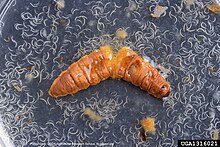Heterorhabditis bacteriophora
| Heterorhabditis bacteriophora | |
|---|---|

| |
| Heterorhabditis bacteriophora nematodes emerging from a greater wax moth. | |
| Scientific classification | |
| Domain: | Eukaryota |
| Kingdom: | Animalia |
| Phylum: | Nematoda |
| Class: | Chromadorea |
| Order: | Rhabditida |
| Family: | Heterorhabditidae |
| Genus: | Heterorhabditis |
| Species: | H. bacteriophora
|
| Binomial name | |
| Heterorhabditis bacteriophora Poinar, 1976
| |
Heterorhabditis bacteriophora is a species of
These beneficial nematodes enter target insect larva via mouth, anus or respiratory openings and starts to feed. To reproduce the nematodes release
Biological Systems Research
These nematodes are amenable to in vitro culture, making them of interest to evolutionary and molecular biologists who investigate parasitic and symbiotic systems.[2] Heterorhabditis bacteriophora was selected by the National Human Genome Research Institute as a sequencing target. The inbred strain H. bacteriophora TTO1 was sequenced using Roche 454 technology, and a high-quality 77 Mb draft genome assembly was produced in 2013.[3]
References
- ^ "Natural pest control with beneficial nematodes". Gardeninsects.com. Retrieved 2011-08-26.
- S2CID 23938830.
- PMID 23874975.
External links
- Leung T (2017-01-11). "Parasite of the Day: Heterorhabditis bacteriophora". Parasite of the Day. Retrieved 2017-11-14.
